P3 advocates seek a playing field advantage before negotiations begin
P3s (Public-Private Partnerships), are simply another procurement tool in the legislative toolbox said John Parkinson. Such a tool “can be applied to something other than a road, a bridge or a tunnel… We have lots of examples of social infrastructure across the country where this has been successfully applied. “It’s a best practice to allow that,” continued Parkinson, “Whether that
November 29, 2016, 8:00 am
By Uprise RI Staff
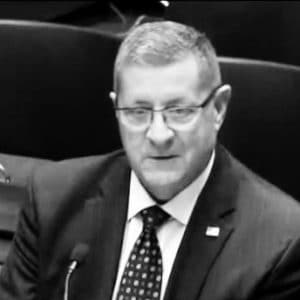
John Parkinson
P3s (Public-Private Partnerships), are simply another procurement tool in the legislative toolbox said John Parkinson. Such a tool “can be applied to something other than a road, a bridge or a tunnel… We have lots of examples of social infrastructure across the country where this has been successfully applied.
“It’s a best practice to allow that,” continued Parkinson, “Whether that hammer is applied to a aggregation of schools that might be modernized or to a group of water treatment facilities, whether that’s the case or not isn’t as material as you’ve got the tool to do that.” [emphasis mine]
Parkinson, executive director of AIAI (Association for the Improvement of American Infrastructure), was speaking at the State House Commission meeting to explore the expansion of P3s in Rhode Island. He and Joseph Aiello, director of business development North America at Meridiam were the third presenters of the day.
In many ways the two corporate representatives reiterated what came before, but there was also a a sense that with the groundwork having been laid by the previous speakers, the blunt talk of what exactly these giant construction and finance corporations want from our state could be plainly stated.
And what was plainly stated is that these corporations have their eyes not just on our roads, bridges and airports, the are looking at our social infrastructure: our schools, our parks, our water and more.
“If you’re designing a program [for P3s],” said Parkinson, “you should design it with something other than ‘this 12 mile stretch’ or ‘this 21.4 mile widening and capacity expansion’ in mind. It really ought to be with the broad infrastructure needs of the State of Rhode Island taken into consideration.”
At the commission meeting Parkinson presented a slide that showed that the corporations he represents are eyeing transportation infrastructure, municipal buildings, education, utilities, healthcare and senior living facilities, safety and security infrastructure (including police, fire, first responders and jails), disposal, leisure and cultural spaces and community use areas such as parks and open spaces.
In other words, pretty much all aspects of public life:
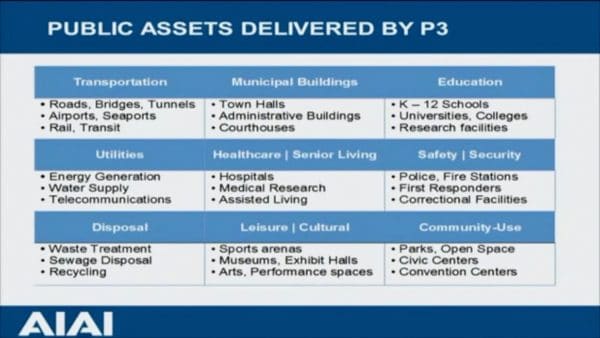
To pave the way for this, our legislators are being asked to create, through legislation and regulation, a “project pipeline” that streamlines and standardizes the P3 process. One of the features of this pipeline is that it handicaps government oversight and involvement in the procurement process.

Joseph Aiello
The role of legislative bodies is to set the regulations and tone, said Aiello, but legislatures become a “deadly disease” when “allowed to approve the deal at the back end.”
“It’s not that legislative bodies are inherently evil people,” continued Aiello, “they’re not. But they’re changed people. You have a governor who typically have four years, and in that first year they begin a procurement process. These procurement processes typically last for around three years. It’s quite frequent that every two years you have a different set of folks chairing a variety of committees in the legislative houses, so you have completely different folks there that didn’t know the deal in the first place and may have wildly different views.”
“So I think,” said Aiello, summing up, “in terms of best practices, what we observed is the need for the legislature to weigh in on the law, the need of the legislation to weigh in on the promulgation and regulation and to pre-approve other criteria in advance by which projects need to demonstrate that they’d meet that criteria…
“But try to avoid a legislative blessing at the back end.”
Again, there’s that corporate distrust of democracy I noted in a previous piece in this series. These company officials want our procurement processes to be inviting, streamlined and pinned down in such a way as to require us to give up all our power at the front end so that the overly complicated and one-sided deal we are stuck with at the end of the process cannot be rejected once we realize what a stinker it is.
Additionally, only the people’s side of the process is expected to be uniform. P3s themselves are much wilder and creative. “Once you’ve seen one P3,” said Parkinson, “you’ve seen one P3.”
Every P3 will be crafted differently, not only in its scope, but in the legal and financial balances struck between the government and the corporation. On one side is a billion dollar corporation with some of the finest legal and financial minds in the world crafting a deal to maximize its profits and minimize its risk. On the other side is a municipal government that has voluntarily hamstrung itself with a streamlined procurement process and no legislative parachute. Think David versus Goliath, but David chopped off his arms before battle.
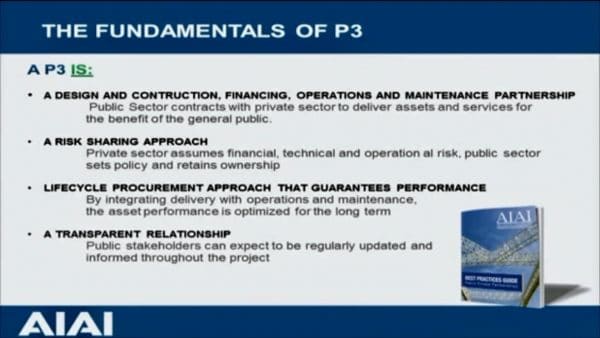
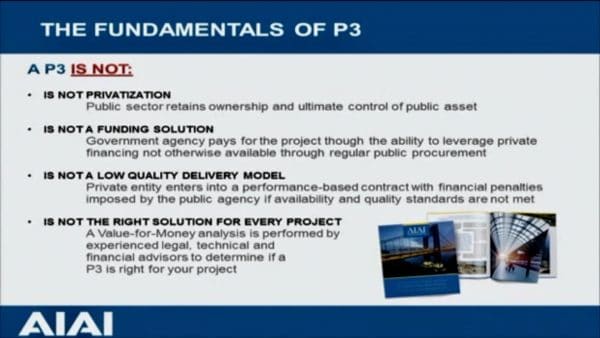
Aiello had some interesting words about tolling. Since many P3s financialize a project through the use of tolls, “you may decide to toll a facility so you can raise some revenue,” said Aiello, “and you can make a second, separate decision to say we, the government, want to retain collection of the toll and the toll risk because of a variety of reasons which may be that despite your best efforts of communicating and showing documentation to the contrary, the public just doesn’t trust having the tolls in the hands of the private sector. Whether its privacy concerns or concerns about the ability to sneak in rate increases that nobody can figure out…
“None of that happens, by the way.”
P3s are not privatization, said Parkinson, and “not a funding solution… It’s a common misperception that, you know, when you talk about, ‘I don’t have enough money to build this project so let’s do a P3.’ That’s not what this is about.”
So if a municipality can’t raise the funds for a project themselves, they shouldn’t look to a P3 as a solution, begging the question, why look to a P3 at all? Looking at the slide shown by Parkinson entitled “Benefits of P3s,” (below) it’s hard to spot a benefit that a traditional procurement process can’t bring.
“The use of P3s is not an excuse for the government to walk away from it’s obligation to protect the public interest,” cautioned Aiello. Instead, the government is expected to be very involved with the project.
But, cautioned Aiello, despite all that was said so far at the commission meeting, it’s a best practice to communicate to the stakeholders and regulatory agencies about P3s, “as if it were still a normal project.”
But as we are starting to realize, P3s are far from nomal.
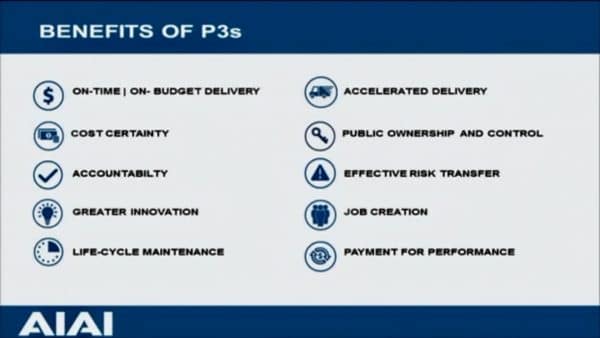
Before I finish I want to include Parkinson’s thoughts on the recent elections, in which he struck a cautiously hopeful tone. Parkinson starts out strong, but quickly devolves into corporate buzz words before trailing off entirely:
“In all of the excitement of last Tuesday, one of the important things for us to note, the one policy issue that got addressed in the victory or acceptance speech by President-elect Trump was infrastructure,” said Parkinson, “There are seven new Senators coming into the upper chamber of congress. There’s 55 new members of the House of Representatives. There’s a little uncertainty just yet of what their understanding of policy framework that will contribute to how to execute on the vision or plan for investment in public infrastructure…”
UpriseRI is entirely supported by donations and advertising. Every little bit helps:
![]()


